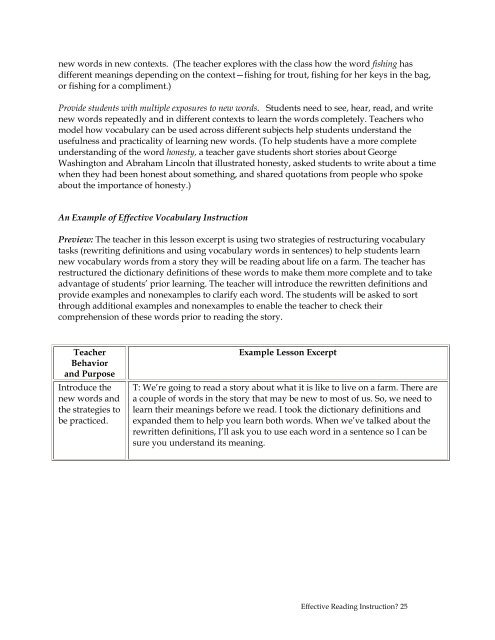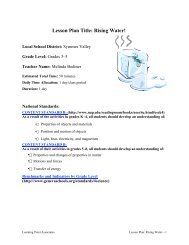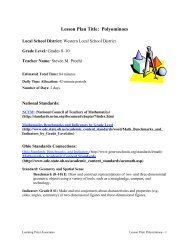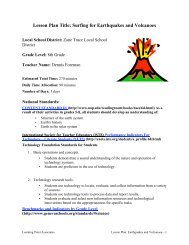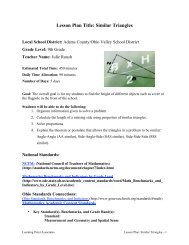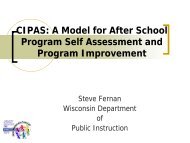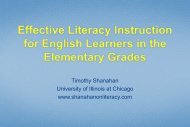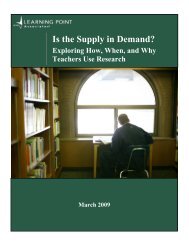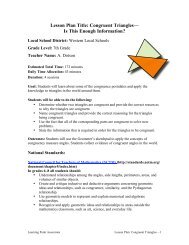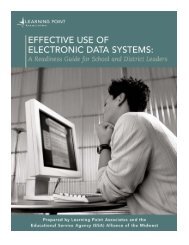A Closer Look at the Five Essential Components - Learning Point ...
A Closer Look at the Five Essential Components - Learning Point ...
A Closer Look at the Five Essential Components - Learning Point ...
You also want an ePaper? Increase the reach of your titles
YUMPU automatically turns print PDFs into web optimized ePapers that Google loves.
new words in new contexts. (The teacher explores with <strong>the</strong> class how <strong>the</strong> word fishing has<br />
different meanings depending on <strong>the</strong> context—fishing for trout, fishing for her keys in <strong>the</strong> bag,<br />
or fishing for a compliment.)<br />
Provide students with multiple exposures to new words. Students need to see, hear, read, and write<br />
new words repe<strong>at</strong>edly and in different contexts to learn <strong>the</strong> words completely. Teachers who<br />
model how vocabulary can be used across different subjects help students understand <strong>the</strong><br />
usefulness and practicality of learning new words. (To help students have a more complete<br />
understanding of <strong>the</strong> word honesty, a teacher gave students short stories about George<br />
Washington and Abraham Lincoln th<strong>at</strong> illustr<strong>at</strong>ed honesty, asked students to write about a time<br />
when <strong>the</strong>y had been honest about something, and shared quot<strong>at</strong>ions from people who spoke<br />
about <strong>the</strong> importance of honesty.)<br />
An Example of Effective Vocabulary Instruction<br />
Preview: The teacher in this lesson excerpt is using two str<strong>at</strong>egies of restructuring vocabulary<br />
tasks (rewriting definitions and using vocabulary words in sentences) to help students learn<br />
new vocabulary words from a story <strong>the</strong>y will be reading about life on a farm. The teacher has<br />
restructured <strong>the</strong> dictionary definitions of <strong>the</strong>se words to make <strong>the</strong>m more complete and to take<br />
advantage of students’ prior learning. The teacher will introduce <strong>the</strong> rewritten definitions and<br />
provide examples and nonexamples to clarify each word. The students will be asked to sort<br />
through additional examples and nonexamples to enable <strong>the</strong> teacher to check <strong>the</strong>ir<br />
comprehension of <strong>the</strong>se words prior to reading <strong>the</strong> story.<br />
Teacher<br />
Behavior<br />
and Purpose<br />
Introduce <strong>the</strong><br />
new words and<br />
<strong>the</strong> str<strong>at</strong>egies to<br />
be practiced.<br />
Example Lesson Excerpt<br />
T: We’re going to read a story about wh<strong>at</strong> it is like to live on a farm. There are<br />
a couple of words in <strong>the</strong> story th<strong>at</strong> may be new to most of us. So, we need to<br />
learn <strong>the</strong>ir meanings before we read. I took <strong>the</strong> dictionary definitions and<br />
expanded <strong>the</strong>m to help you learn both words. When we’ve talked about <strong>the</strong><br />
rewritten definitions, I’ll ask you to use each word in a sentence so I can be<br />
sure you understand its meaning.<br />
Effective Reading Instruction? 25


